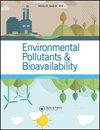用液相色谱法和电感耦合等离子体质谱法测定人体尿液中硒的形态
Q3 Chemical Engineering
引用次数: 8
摘要
摘要采用混合离子对反相色谱法和电感耦合等离子体质谱联用法对尿中硒代谢物进行了形态分析。色谱分离采用C8固定相,流动相为2.5 mmol L−1丁烷磺酸钠、8 mmol L−1四甲基氢氧化铵、4 mmol L−1丙二酸、0.05%甲醇,pH为3.0。在此条件下,成功分离了亚硒酸盐、硒酸盐、硒代蛋氨酸、硒代蛋氨酸、硒脲、三甲基硒铵和硒甲基硒半胱氨酸。采用80Se监测法测定硒含量。在流动相中加入内标Ge。所有物种的校准至少在100 μg L−1 Se范围内呈线性。检出限为0.4 μ L−1 Se。当使用更高(1400 W)的ICP功率时,仅基于硒酸盐的校准为所有物种提供了准确的结果。稳定性试验表明亚硒酸盐的稳定性极短。收集后,尿液样本应酸化至pH 3.0,在-5℃以下保存,收集后12 h前分析。本方法采用短时间(单粒,1 d观察,5人)监测含硒膳食补充剂摄入后硒的排泄情况。当使用含有硒酸盐的配方时,在24小时内几乎有50%的硒被排出体外(大部分以硒酸盐的形式排出),血浆中的硒保持不变。在有机结合硒的情况下,24小时内只有8%的硒以亚硒酸盐、硒甲基硒半胱氨酸、硒代蛋氨酸和未知的形式通过排尿损失。随后,观察到血浆硒含量有统计学意义的增加。本文章由计算机程序翻译,如有差异,请以英文原文为准。
Speciation analysis of selenium in human urine by liquid chromatography and inductively coupled plasma mass spectrometry for monitoring of selenium in body fluids
Abstract Speciation analysis of selenium metabolites in urine was performed using hyphenation of mixed ion-pair reversed-phase chromatography and inductively coupled plasma mass spectrometry. A chromatographic separation was performed with a C8 stationary phase and a mobile phase containing 2.5 mmol L−1 sodium butane-1-sulfonate, 8 mmol L−1 tetramethylammonium hydroxide, 4 mmol L−1 malonic acid, and 0.05% methanol, pH 3.0. Under this condition, the selenium species selenite, selenate, selenomethionine, selenoethionine, selenourea, trimethylselenonium, and Se-methylselenocysteine were successfully separated. Selenium determination was carried out by monitoring 80Se. The internal standard Ge was added into the mobile phase. The calibration was linear at least up to 100 μg L−1 Se for all species. The limit of detection was 0.4 μg L−1 Se. When higher (1400 W) ICP power was applied, the calibration based solely on selenate provided accurate results for all species. Stability tests revealed extremely short stability of selenite. After collection, the urine samples should be acidified to pH 3.0, stored below –5 °C, and analyzed before 12 h after collection. The method was used for the short-time (single capsule, one day observation, 5 persons) monitoring of the excretion of selenium after ingestion of Se-containing dietary supplements. When a formulation containing selenate was applied, almost 50% of Se was excreted during 24 h (mostly in the unchanged form of selenate) and the plasma Se remained unaltered. In the case of organically bound Se, only 8% of Se was lost by urination during 24 h as selenite, Se-methylselenocysteine, selenomethionine, and unknown species. Subsequently, a statistically significant increase of plasma Se was observed.
求助全文
通过发布文献求助,成功后即可免费获取论文全文。
去求助
来源期刊
CiteScore
1.62
自引率
0.00%
发文量
0
审稿时长
1 months
期刊介绍:
Chemical Speciation & Bioavailability ( CS&B) is a scholarly, peer-reviewed forum for insights on the chemical aspects of occurrence, distribution, transport, transformation, transfer, fate, and effects of substances in the environment and biota, and their impacts on the uptake of the substances by living organisms. Substances of interests include both beneficial and toxic ones, especially nutrients, heavy metals, persistent organic pollutants, and emerging contaminants, such as engineered nanomaterials, as well as pharmaceuticals and personal-care products as pollutants. It is the aim of this Journal to develop an international community of experienced colleagues to promote the research, discussion, review, and spread of information on chemical speciation and bioavailability, which is a topic of interest to researchers in many disciplines, including environmental, chemical, biological, food, medical, toxicology, and health sciences.
Key themes in the scope of the Journal include, but are not limited to, the following “6Ms”:
Methods for speciation analysis and the evaluation of bioavailability, especially the development, validation, and application of novel methods and techniques.
Media that sustain the processes of release, distribution, transformation, and transfer of chemical speciation; of particular interest are emerging contaminants, such as engineered nanomaterials, pharmaceuticals, and personal-care products.
Mobility of substance species in environment and biota, either spatially or temporally.
Matters that influence the chemical speciation and bioavailability, mainly environmentally relevant conditions.
Mechanisms that govern the transport, transformation, transfer, and fate of chemical speciation in the environment, and the biouptake of substances.
Models for the simulation of chemical speciation and bioavailability, and for the prediction of toxicity.
Chemical Speciation & Bioavailability is a fully open access journal. This means all submitted articles will, if accepted, be available for anyone to read, anywhere, at any time. immediately on publication. There are no charges for submission to this journal.

 求助内容:
求助内容: 应助结果提醒方式:
应助结果提醒方式:


